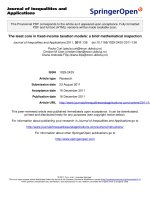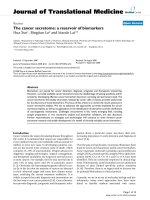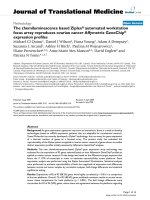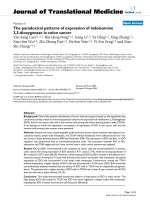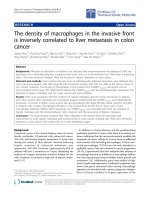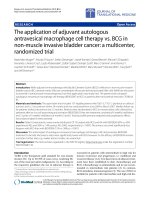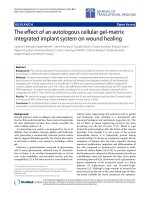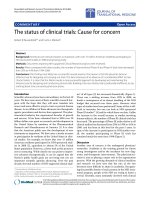báo cáo hóa học: " The acute inflammatory response to intranigral a-synuclein differs significantly from intranigral lipopolysaccharide and is exacerbated by peripheral inflammation" pptx
Bạn đang xem bản rút gọn của tài liệu. Xem và tải ngay bản đầy đủ của tài liệu tại đây (3.36 MB, 14 trang )
RESEARC H Open Access
The acute inflammatory response to intranigral
a-synuclein differs significantly from intranigral
lipopolysaccharide and is exacerbated by
peripheral inflammation
Yvonne Couch
1
, Lydia Alvarez-Erviti
2
, Nicola R Sibson
3
, Matthew JA Wood
4
and Daniel C Anthony
1*
Abstract
Background: Activated microglia are a feature of the host response to neurodegeneration in Parkinson’s disease
(PD) and are thought to contribute to disease progression. Recent evidence suggests that extracellular a-synuclein
(eSNCA) may play an important role in the pathogenesis of PD and that this may be mediated by a microglial
response.
Methods: We wished to discover whether the host response to eSNCA would be sufficient to induce significant
cytokine production. In vitro cultured BV-2 microglia were used to determine the basic inflammatory response to
eSNCA. In vivo, 8-week old Biozzi mice were subjected to a single intranigral injection of either 3 μg SNCA,
lipopolysaccharide (LPS) or serum protein (BSA) and allowed to recover for 24 hours. A second cohort of animals
were peripherally challenged with LPS (0.5 mg/kg) 6 hours prior to tissue collection. Inflammation was studied by
quantitative real-time PCR for a number of pro-inflammatory genes and immunohistochemistry for microglial
activation, endothelial activation and cell death.
Results: In vitro data showed a robust microglial response to SNCA, including a positive NFĸB response and the
production of pro-inflammatory cytokines. Direct injection of SNCA into the substantia nigra resulted in the
upregulation of mRNA expression of proinflammatory cytokines, the expres sion of endothelial markers of
inflammation and microglial activation. However, these results were significantly different to those obtained after
direct injection of LPS. By contrast, when the animals were injected intracerebrally with SNCA and subsequently
challenged with systemic LPS, the level of production of IL-1b in the substantia nigra became comparable to that
induced by the direct injection of LPS into the brain. The injection of albumin into the nigra with a peripheral LPS
challenge did not provoke the production of a significant inflammatory response. Direct injection of LPS into the
substantia nigra also induces cell death in a more robust manner than direct injection of either SNCA or BSA.
Conclusion: These results suggest that the presence of eSNCA protein ‘primes’ microglia, making them susceptible
to environmental proinflammatory challenge. For this reason, we hypo thesise that where ‘inflammation’ contributes
to the disease progression in PD, it does so in a punctuate manner (on-off) as a result of systemic events.
Keywords: brain, inflammation, α-synuclein, SNCA, cytokine, Parkinson’ s, chemokine
* Correspondence:
1
Experimental Neuropathology, Department of Pharmacology, University of
Oxford, Oxford, OX1 3QT, UK
Full list of author information is available at the end of the article
Couch et al. Journal of Neuroinflammation 2011, 8:166
/>JOURNAL OF
NEUROINFLAMMATION
© 2011 Couch et al; licensee BioMed Central Ltd. This is an Open Access article distributed under the terms of the Creative Commons
Attribution License ( which permits unrestricted use, distribution, and reproduction in
any medium, provided the original work is properly cited.
Background
Lewy bodies are intracellular deposits containing the
ubiquitous CNS protein a-synuclein (SNCA), and are
the pathological hallmark of Parkinson’sdisease(PD)
[1]. However, speculation co ntinues as to the exact role
of the protein under both healthy and pathological con-
ditions. Brundin et al. have proposed that extracellular
SNCA (eSN CA) may be respon sible for propagating PD
pathology in grafted tissue [2]. The mechanism for the
physiological release is debated, but in vitro studies have
demonstrated that SNCA is secreted by living neurons
and enters t he surrounding medium [3]. It is also possi-
ble that dying neurons release SNCA into the extracellu-
lar space. eSNCA is present in measurable quantities in
cerebrospinal fluid and plasma of individuals with PD.
Various groups have suggested that eSNCA over -stimu-
lates the immune system resulting in a neurotoxic cen-
tral immune phenotype [4,5]. These studies frequently
use in vitro techniques or over-expression models where
the use of specific vectors may interfere with the
immune process [6]. Here we use direct in vi vo appli ca-
tion of SNCA protein to study the inflammatory
response.
The inflammatory response described in PD is
thought to initially result from the activation of micro-
glia [5]. Traditionally, this has been seen to induce a
cascade of proinflammatory cytokines that results in
feed-forward immune stimulation and a hyperactive
inflammatory re sponse. While proinflammatory cyto-
kines have been shown to be present in both post-mor-
tem brains and the cerebrospinal fluid of PD patients
[7-9], it is possible that these inflammatory responses
may, in vivo, be relat ively brief and disguise the true
role of microglia in PD. It is possible, in terms of
eSNCA, that they play a scavenger-like role, merely
clearing debris rather than establishing an inflammatory
response on the scale of that seen with more traditional
mediators of inflammation.
In order to have a good basis for comparison, we
employed an intranigral lipopolysaccharide (LPS) injec-
tion as a positive c ontrol. Recent PD research has used
intranigral injections of LPS as a model of disease
[10,11]. What is important about t hese studies is that
they produced a model of dopaminergic cell death
caused by a local inflammatory response. However, the
inflammation in PD is unlikely to be triggered by the
same pathways activated by LPS. To date, little compari-
son of the in vivo inflammatory effects of SNCA and
LPS has been made.
The aim of the present study was to deter mine the
immune profile resulting from intranigral eSNCA and
further to establish whether this profile differs signifi-
cantly from that induced by LPS administration. Here,
we show that SNCA does generate a significant inflam-
matory response in vitro and in vivo when compared to
control protein, but the response is far less marked than
that seen with LPS. However, we also show that the
inflammatory response to eSNCA is greatly enhanced if
an animal is also given a systemic injection of LPS.
Thus, while the inflammatory profile resulting fr om sti-
mulation with eSNCA or LPS are considerably different,
systemic activation of the immune system can produce a
local inflammatory response to eSNCA that is compar-
able to LPS.
Methods
Materials
SNCA peptide (rPeptide, Georgia, USA) wa s maintained
as a stock solution of 6 μg/μl in phospha te-buffered sal-
ine (PBS; Invitrogen). Amyloid-b peptide (California
Peptide Inc., California, USA) was maintained as a stock
solution of 6 μg/μl in 0.1% dimethylsulfoxide/PBS.
Bovine serum albumin (BSA; S igma-Aldrich, Poole, UK)
was maintained at a stock solution of 6 μg/μlinPBS.
LPS (E. coli 026: B6, Sigma-Aldrich) was maintained as a
stock solution of 10 μg/μl in PBS. Peptide concentra-
tions w ere chosen based on in vitro dose response data
(not included). LPS doses, both central and periphera l,
were based on those currently used in the literature to
produce a robust inflammatory response [11,12].
Cell culture
BV2 cells (a kind gift from Dr. David Brough, University of
Manchester) were maintained in DMEM (GIBCO, Invitro-
gen, Paisley, UK) with 10% heat-inactivated FCS (GIBCO).
Cells were treated with LPS, SNCA or amyloid-b in 12-
well plates (1.5 × 10
5
cells/well) and supernatant samples
were removed at time points up to 48 hours after treat-
ment. Supernatants were analysed for TNFa release by
ELISA (R&D Systems, Abingdon, UK) and plates were
read using a BioRad Model 680 Microplate Reader
(BioRad, Hemel Hempstead, UK). For microscopy, cells
were grown on sterile coverslips and fixed in an ice-cold
3:1 acetone:methano l solution prior to mounting with
DAPI mounting medium (Vector Laboratories).
Animals
Adult female ABH-Biozzi mice (6 months) were
obtained from Charles River and housed under a stan-
dard 12-hour light/dark cycle. Animals were provided
with food and water ad libitum and all procedures were
carried out in accordance with the UK Animals (Scienti-
fic Procedures) Act, 1986. Animals were anaesthetized
in a 2% isoflurane/oxygen mix (2 L/min) and placed in a
stereotactic frame (Stoetling Co., USA) under mainte-
nance anaesthesia (1.5%).
Couch et al. Journal of Neuroinflammation 2011, 8:166
/>Page 2 of 14
Intranigral injection of peptide
The skull was exposed and a hole drilled above the posi-
tion of the substantia nigra pars compacta (SNpc) which
lies -2.9 mm anterior, -1.3 mm lateral and -4.1 mm ven-
tral from Bregma [13]. Injections of 0.5 μl of stock solu-
tionsweremadeusingagraduated glass capillary tube
(Drummond Scientific Company, Broomall, PA, USA)
over 5 minutes (0.1 μl/min) followed by 2 minutes of
rest, to allow diffusion of the inject ed material, prior to
removal of the needle.
LPS challenge
A subset of animals were challenged with LPS at 0.5
mg/kg i.p. 18 hours after receiving intranigral injections.
RNA extraction and cDNA preparation
mRNA was extracted using the RNeasy Mini Kit (Qia-
gen, Crawley, UK) according to the manufacturer’ s
instructions. Briefly, 10-20 mg of frozen tiss ue was s ub-
merged in 300 μl lysis buffer containing 0.001% b-mer-
captoethanol. Tissue samples were homog enised using a
motor-driven disposable plastic pest le and the resulting
suspension transferred to a Qiashredder Mini Spin
®
col-
umn which was then centrifuged at maximum speed in
a microcentrifuge. The resulting lysate was mixed 1:1
with 70% ethanol and centrifuged through an RNeasy
Mini Spin
®
column. The column was washed and trea-
ted with DNAse 1 for 15 minutes. The column was
washed again to remove any final contaminants and
RNA was eluted using RNase-free water. RNA samples
were then diluted as necessary in o rde r to input 400 ng
total RNA into a 10 μl-reverse-transcription reaction.
cDNA was synthesised using a Taqman
®
Reverse Tran-
scription Reagent Kit (Applied Biosystems, Warrington,
UK) as per the manufacturer’s instructions.
Quantitative PCR
RT-PCR assays were performed as previously described
[14]. Samples were run against standard curves gener-
ated from serially-diluted cDNA from LPS-challenged
mouse l iver. Primer and probe sets for mouse NFkB, IL-
1b,TNFa ,TGFb,COX2andIL-6weredesignedusing
the Roche universal probe library assay design centre.
Samples were ana lyzed using a Roche Light Cycler 480
®
(Roche Diagnostics, Welwyn Garden City, UK) and all
reagents were used according to manufacturer’s instruc-
tions. Briefly, gene-specific primers were designed and
combined with a FAM/TAMRA labe lled hybridization
probe. PCR was run according to standard conditions
[14]. Analysis was performed using the standard curve
to determine reaction effici ency followed by a compara-
tive-cycle-threshold method. Results were expressed as
relative expression corrected to the house-keeping gene
glyceraldehyde phosphate dehydrogenase (GAPDH).
Nuclear and cytosolic p65 protein analysis
Fresh tissue was extracted from the injection site and run
through the ProteoExtract kit (Merck, Nottingham, UK).
Briefly, tissue was mixed with 250 μl Extraction Buffer 1
(including protease inhibitors) and incubated at 4°C for 10
minutes under agitation. Insoluble material was pelleted at
1000 G at 4°C for 10 min and t he resulting supernatant,
the cytosolic subproteome, was removed and stored. The
pellet was mixed with 250 μl Extraction Buffer 2 and incu-
bated for 30 min at 4°C under agitation. The insoluble
material was pelleted at 6000 G at 4°C for 10 min. The
supernatant, the m embrane/organelle subproteome, was
removed and the pellet mixed with 125 μl Extraction Buf-
fer 3 (including 1.5 μl Benzonase). Following 10 min of
incubation at 4°C the insoluble material was pelleted at
7000 G at 4°C for 10 min and the supernatant, the nuclear
fraction, was removed. The final fraction, the cytoskeletal
subproteome, was discarded. Western blots were per-
formed on the nuclear and cytosolic subproteomal frac-
tions. Subcellular fractions were analyzed by 1DE western
blot probing for p65 (AbCam, UK), using actin (cytosolic)
and HCDA1 (nuclear) as housekeeping proteins. Quantifi-
cation was performed using ImageJ software using BSA
injected animals as controls.
Tissue preparation
Animals were surgically anaesthetised with 0.1 ml pen-
tobarbitone and trans cardially perfused with heparinised
saline (0.9%) followed by a periodate lysine paraformal-
dehyde solution (PLP: 2% paraformaldehyde, lysine, peri-
odate and 0.05% glutaraldehyde). Brains were removed,
post-fixed in PLP for 4 hoursandfurtherfixedin30%
sucrose for > 12 h ours. 10 μm-sections were cut on a
cryostat (Leica, Bucks, UK) and mounted on gelatine-
coated slides.
Immunohistochemistry
An avidin-biotin-peroxidase method was employed for
stai ning the tissue sections [15]. Antigens were detected
using antibodies against Iba-1 (Abcam, Cambridge, UK)
to detect activated microglia and ICAM-1 (Abcam)
Binding was detected using a biotinylated secondary
antibody and an ABC standard kit (Vector Laboratories).
Visu alization was perfor med using a 0.05% diaminoben-
zene hydrochloride solution (DAB; Sigma). ICAM-1 and
Iba1 analysis was performed using a light microscope
(Nikon Labophot-2, Sur rey, UK) fitted with an eyepiece
graticule of known area. Vessels were counted in areas
of highest density around the site of injection and
expressed as number of vessels per mm
2
. TUNEL label-
ling was performed using a NeuroTacs kit (R&D Sys-
tems, Abingdon, UK) as per the manufacturer’ s
instructions and developed using a light microscopy-
based method (DAB).
Couch et al. Journal of Neuroinflammation 2011, 8:166
/>Page 3 of 14
Results
SNCA and amyloid-b cause NFĸB subunit p65 to migrate
to the nucleus
In order to establish whether SNCA and amyloid-b
caused changes in inflammatory gene expression via the
NFĸB pathway in vitro an immortalised murine micro-
glial cell line, BV2, was used. Cells were treated with
PBS (Figure 1A-C), 3 μg SNCA (Figure 1D-F), or 3 μg
amyloid- b (Figure 1G-I) . The cells were fixed with acet-
one/methanol at 30 minut es, 6 hours and 24 hours. The
NFĸB p65 subunit was visualised by immunohistochem-
istry and the cells were counterstained with DAPI to
examine whether the p 65 subunit had translocated.
From 30 minutes onwards, treatment with SNCA or
amyloid-b caused nuclear translocation of the p65 subu-
nit, which was not observed after PBS at any time point.
The p65 subunit remained co-localised with the DAPI-
stained nucleus 24 hours after the protein treatments.
Co-localization analysis from 30 minutes onwards
revealed an average Mander’s correlation co-efficient of
0.998 in treated cells compared to 0.312 in untreated
cells. This indicates a high degree of quantifiable co-
localization between DAPI and NFkB in treated groups.
SNCA, but not amyloid-b, produces significant TNFa
release from cultured microglial cells
To discover whether SNCA or amyloid-b can be consid-
ered proinflammatory per se, BV2 cells were incubated
with PBS, 3 μgSNCA,3μg amyloid-b,or10ng(100
EU) LPS as a positive proinflammatory control. Super-
natant samples were collected from 5 minutes until 48
hours hours after the application (Figure 2). The level of
TNF release was determined by ELISA. TNF production
was a feature of all the treatment regimes except PBS.
However, despite the similarity in p65 translocation
observed after SNCA and amyloid-b treatment, there
were clear differences in the extent of TNF release. At 2
hours SNCA produced significantly more TNF than
amyloid-b, and the level of TNF continued to rise. TNF
produced after SNCA treatment was comparable to that
Figure 1 NFĸB p65 subunit translocation to the nucleus 24 h after treatment with a-synuclein (SNCA) or amyloid-b. Cells were treated
with vehicle (A-C); 3 μg SNCA (D-F) or 3 μg amyloid-b (G-I) for 24 hours at which point cells were fixed and immunostained for the p65 subunit
of NFĸB (green; localization indicated by white arrows) and mounted in medium containing the nuclear stain DAPI. Note that SNCA and
amyloid-b caused the p65 subunit to translocate to the nucleus (blue; co-localization indicated by red arrows). Scale bar represents 50 μm.
Couch et al. Journal of Neuroinflammation 2011, 8:166
/>Page 4 of 14
observed with LPS, moreover, by 48 hours SNCA
induced more TNF than the LPS treatment. The small
initial increase in the level of TNF expression observed
after amyloid-b treatment remained unchanged through-
out the rest of the time course.
Direct injection of SNCA into the SNpc upregulates
proinflammatory cytokine mRNA
As amyloid-b had no significant proinflammatory effects
in vitro we examined the in vivo effects of SNCA, bovine
serum albumin (BSA), or LPS administration directly
into the SNpc. We found that 24 hours after microinjec-
tion of SNCA into the SNpc, the mRNA of the major
proinflammatory cytokines, IL-1b,IL-6andTNFa,were
significantly up-regulated compared to the BSA co ntrols
(Figure 3). Both eSNCA and BSA failed to alter transcrip-
tion of NFĸB (p65) (Figure 3A). However, the microinjec-
tion of SNCA did result in a 2-fold increase in TNFa
gene expression when compared to the contralateral
hem isphere of BSA injected animal s (Figure 3B). eSNCA
produced a significant 5-fold increase in the levels of IL-
1b mRNA expression when compared to BSA injected
animals (Figure 3C). Similarly, IL-6 is increa sed after
treatment with SNCA compared to BSA animals (Figure
3D). Finally, we found significant increases in TGFb
(2.75-fold) and COX-2 (10-fold) mRNA levels in the ipsi-
lateral hemisphere of SNCA injected animals when com-
pared to the contralateral hemisphere of BSA injected
animals (Figure 3E &3F).
The cytokine profile after LPS injection into the SNpc
significantly differs from direct SNCA injection
Direct injection of endotoxin into the SNpc is now fre-
quently used as a model of PD-like neurodegeneration.
We aimed to determine whether the inflammatory profile
seen with this method differed significantly to that
obtained with eSNCA. Microinjection of LPS increased
mRNA for NFĸB 4-fold, greater than eSNCA bu t not sig-
nificant (Figure 4A). However, microinjection of LPS
results in a 77 k- fold increase in TNF mRNA expression
(Figure 4B). Increases in IL-1b (1200-fold; Figure 4C) and
IL-6 (400-fold; Figure 4D) mRNA expression, measured
after LPS microinjection, were significantly higher than
the ipsilateral hemisphere of SNCA injected animals.
After injecting LPS, mRNA for TGFb incre ased 6-fold
(Figure 4E), significantl y different from the levels
recorded in the contralateral hemisphere of BSA injected
animals and double those recorded after microinjection
of SNCA. A 30-fold (Figure 4F) increase in COX-2
mRNA was observed after central LPS administration, 3-
fold higher than the increase seen with eSNCA.
eSNCA causes significant activation of microglia
Microglial activation was analyzed by immunohisto-
chemistry using an anti Iba-1 antibody, which recognises
ionized calcium binding adaptor molecule-1, an EF-hand
protein that is expressed by microglia and up-regulated
during episodes of inflammation. At 24 hours there was
a significant increase in the number of Iba-1-positive
cells (Figure 5A) in the ipsilateral hemisphere of SNCA-
injected animals when compared to the contralateral
hemisphere (Figure 5B). There were also significantly
more activated microglia in SNCA-injected animals in
the ipsilateral hemisphere when compared to the ipsilat-
eral hemisphere of BSA-injected animals (Figure 5F).
eSNCA upregulates markers of vascular inflammation
Intercellular adhe sion molecule (ICAM) expression after
SNCA and BSA treatment was analysed by immunohisto-
chemistry using an anti-ICAM-1 antibody. ICAM is ubi-
quitously expressed at low concentrations but will increase
after exposure to proinflammatory cytokines in order to
facilitate leukocyte migration across the endothel ium. At
24 hours there was a significant increase in the number of
ICAM-1-positive vessels (Figure 5C) in the ipsilateral
hemisphere of SNCA-injected animals when compared to
the contralateral hemisphere (Figure 5D). There were also
significantlymoreICAM-1-positive vessels in SNCA-
injected animals in the ipsilateral hemisphere when com-
pared to the ipsilateral hemisphere of BSA-injected ani-
mals (Figure 5E). Vascular cell adhesion molecule
(VCAM) expression was analyzed by immunohistochemis-
try using an anti-rat VCAM antibody produced in-house
(results not shown). Unlike ICAM, VCAM is only
expressed during inflammatory episodes when the micro-
vasculature has been exposed to proinflammatory cyto-
kines. Very little VCAM staining was observed in the
parenchyma at any time point after any treatment.
Figure 2 TNFa release from BV2 cells increases after treatment
with LPS and SNCA but not with amyloid-b. Histogram shows
TNFa release (pg/ml) from BV-2 cells as assessed by ELISA at time-
points after treatment with vehicle (PBS), 3 μg SNCA, 3 μg amyloid-
b or 10 ng LPS. Error bars represent mean ± S.E.M. * represents P <
0.05; ** represents P < 0.01 and *** represents P < 0.001 when
compared to control values. # represents significance compared to
amyloid-b.
Couch et al. Journal of Neuroinflammation 2011, 8:166
/>Page 5 of 14
Peripheral LPS exacerbates the proinflammatory potential
of eSNCA
As systemic infections are known to contribute to the
progression of many neurological diseases, we were
interested to discover whether the activation of the
innate immune system by LPS would affect the host
response to eSNCA. Groups of animals were challenged
with either systemic LPS or saline at 18 hours after the
injection o f either SNCA or BSA into the SNpc. At 24
hours, when the animals were killed, TNF was elevated
by the systemic LPS challenge in both the ipsilateral and
contralateral hemispheres, and the level of expressi on
Figure 3 Cytokine mRNA expression in the brain 24 hours after SNCA or BSA injection into the substantia nigra. mRNA levels of (A)
NFĸB; (B) TNFa; (C) IL-1b; (D) IL-6; (E) TGFb and (F) COX-2 measured as values relative to GAPDH and normalized to levels within the
contralateral hemisphere of control animals. Error bars indicate mean ± SEM. Dotted line represents basal levels in naïve animals. * indicates a
significance of P < 0.05 when compared to naïve animals; **indicates P < 0.01 and *** indicates P < 0.005.
Couch et al. Journal of Neuroinflammation 2011, 8:166
/>Page 6 of 14
Figure 4 Cytokine mRNA expression in the brain 24 hours after LPS injection into the substantia nigra. mRNA levels of (A) NFkB; (B) TNF;
(C) IL-1b; (D) IL-6; (E) TGFb and (F) COX-2 measured as values relative to GAPDH and normalized to levels within the contralateral hemisphere of
control animals. Error bars indicate mean ± SEM. Dotted line represents basal levels in naïve animals. * indicates a significance of P < 0.05 when
compared to naïve animals and *** indicates P < 0.005.
Couch et al. Journal of Neuroinflammation 2011, 8:166
/>Page 7 of 14
A B
C D
E F
BSA
Alpha Synuclein
LPS
BSA & i.p. LPS
Alpha Synuclein & i.p. LPS
Figure 5 Increased Iba-1 and ICAM-1 expression 24 hours after intranigral administration of SNCA. Representat ive microscopy showing
typical Iba-1 (A & B) and ICAM-1 (C & D) staining seen 24 h after injection of SNCA (A & C) or BSA (B & D; both micrographs are counterstained
with cresyl violet). Scale bar represents 10 μm. The number of Iba-1-positive microglia (E) or ICAM-1- positive vessels were quantified in both
SNCA and BSA injected animals.
Couch et al. Journal of Neuroinflammation 2011, 8:166
/>Page 8 of 14
was independent of the substance injected into S N (Fig-
ure 6 ). However, the levels of IL-6 and IL-1b were sig-
nificantly elevated by the LPS challenge compared to
SNCA controls with no systemic challenge. In the BSA
injected animals IL-6 and IL-1 were not significantly dif-
ferent from naïve controls. It is interesting to note that
contralaterally IL-6 and IL-1 were also significantly ele-
vated by the systemic LPS treatment to levels that are
comparable to the central injection of LPS. COX-2
expression in the SNpc was unaltered by systemic LPS
treatment, but TGF-b expression was significantly
increased by the LPS challenge in the SCNA-tre ated
Figure 6 Cytokine mRNA expression in the brain 24 hours after SNCA, BSA or LPS injection into the substantia nigra with and without
peripheral LPS challenge. mRNA levels of (A) NFkB; (B) TNFa; (C) IL-1b; (D) IL-6; (E) TGFb and (F) COX-2 measured as values relative to GAPDH
and normalized to levels within the contralateral hemisphere of control animals. Bars show mean ± SEM. * indicates a significance of P < 0.05
when compared to non-LPS-injected control animals; **indicates P < 0.01 and *** indicates P < 0.005.
Couch et al. Journal of Neuroinflammation 2011, 8:166
/>Page 9 of 14
animals alone. While NFĸB mRNA expression was unaf-
fected by the challenge, Western blot analysis of protein
from the inject ed hemisphere revealed that p65 nuclear
translocation was elevated in SNCA-treated animals,
and that a systemic LPS challenge exacerbated this
response (Figure 7).
Central LPS causes cell death
Cell death via apoptosis is an important aspect of a
number of neurodegenerative diseases. In order to
determine whether the microglia were simply phagocy-
tosing dead cells or actively clearing up damaged ones,
it was important to quantify cell d eath. Using the same
groups as previously described nick-end labelling was
used to quantify the number of cells undergoing apopto-
sis at 24 hours post challenge. Only in brains injected
directly with LPS were the cells quantifiable (Figure 8D)
and clearly visible (Figure 8A). A few isolated TUNNEL-
positive cells were observed af ter SNCA injection, but
the number of positive cells wa s negligible compar ed to
those observed in LPS-injected brains.
Discussion
The purpose of this study was to investigate the inflam-
matory properties of SNCA in vitro and in vivo.Our
data reveals that non-aggregated wild-type (wt) synthetic
human SNCA produces an inflammatory response in
vitro, as demonstrated by the translocation of the p65
Cytoplasmic Nuclear
BSA BSA+LPS SNCA SNCA+LPS BSA BSA+LPS SNCA SNCA+LPS
A
ctin HCDA1
BSA
BSA & i.p. LPS
SNCA
S
NCA & i.p. LPS
0.0
2.5
5.0
7.5
10.0
12.5
15.0
Relative-Fold
Protein Expression
(Arbitrary Units)
A
B
*
**
Figure 7 p65 nuclear translocation in injected hemisphere 24 after BSA or SNCA injection into the substantia nigra with and without
peripheral LPS challenge. (A) p65 protein was visible in both cytosolic and nuclear fractions of brain protein lysate of injected animals. p65
protein levels within the nuclear fraction (B) were measured as relative-fold changes compared to non-LPS injected control animals. * indicates a
significance of P < 0.05 when compared to non-LPS injected controls; ** indicates a significance of P < 0.01 when compared to non-LPS SNCA
controls.
Couch et al. Journal of Neuroinflammation 2011, 8:166
/>Page 10 of 14
subunit of NFĸB and the release of TNFa into the sur-
rounding medium, as well as an in vivo response. How-
ever, to put the qPCR data from SNCA-injected animals
into context, a second group of mice received a single
intranigral injection of LPS and were allowed to survive
for 24 hours prior t o tissue processing. The expression
levels of proinflamm atory mRNA were consistently
increased for LPS-injected mice compared to SNCA-
injected mice, sugge sting that the LPS challenges used
to model PD are unlikely t o be pathophysiologically
relevant. However, when the animals were injected
intracerebrally with SNCA and sub sequently challenged
with systemic LPS the level of production of IL-1b in
the SNpc was comparable t o that induced by the direct
injection of LPS into the brain. The injection of albumin
into the SNpc with a peripheral LPS challenge did not
provoke the production of IL-1b. Thus, the inflamma-
tory response to eSNCA is context sensitive and
suggests the contribution of inflammation induced by
eSNCA to the progression of PD is greatly augmented
by peripheral immune activation. The significance of
these data is discussed below.
NFĸB exists as a heterodimer of p65 and p50, which,
in the resting state, has a cytoplasmic distribution. The
activation of macrophages by proinflammatory cytokines
and by scavenger receptors causes the NFĸBheterodi-
mer to dissociate from its IkB inhibitory accessory subu-
nit and translocate to the nucleus [16]. Our initial
findingsshowthatbothwtSNCAandwtamyloid-b
induce NFĸB-p65-subunit translocatio n to the nucleus.
Others have isolated cytosolic and nuclear fractions of
murine microglia and demonstrated the translocation of
p65 after one hour of treatment with nitrated SNCA,
but no comparison with amyloid-b was performed [17].
While SNCA and amyloid-b both caused translocation
of p65, downstream TNF production in response to
AB
CD
Figure 8 Cell death in injected hemisphere 24 h after SNCA, BSA or LPS injection into the substantia nigra with and without
peripheral LPS challenge. TUNEL staining was clearly visible in LPS-injected (A) animals but TUNEL was rarely seen in SNCA injected animals
(B). No TUNEL staining was observed in BSA-injected brain (C; representative image). Nuclease treated positive control section (D). Data are mean
± SEM, *** indicates a significance of P < 0.005 when compared to the contralateral hemisphere. Scale bar represents 10 μm.
Couch et al. Journal of Neuroinflammation 2011, 8:166
/>Page 11 of 14
these challenges was quite different. SNCA gave rise to a
rapid and sustained TNF response in BV2 microglial
cells, which exceeded the response generated by LPS.
Amyloi d-b-induced TNF production was trivial by com-
parison. These results suggest that LPS, SNCA, and
amyloid-b activate BV2 cells in a distinct manner. It is
also possible that the amyloid-b is cleared more rapidly
than SNCA by the BV2 cells. Indeed, results indicate
that amyloid-b is rapidly produced and cleared from the
CNS in humans and that about 8% of extracellular amy-
loid-b is turned over each hour [18]. Thus microglial
cells are likely to be constan tly exposed to amyloid-b,
and eSNCA exposure is likely to be more rare. The
exposed residues of peptides such as SNCA and amy-
loid-b may also alter the inflammatory response. Work
with the shorter 25-35-residue fragment of amyloid-b is
often u ndertaken because it produc es exaggerated toxi-
cological properties when compared to the full-length
peptide [19-21]. Indeed, the treatment of astrocytes with
full-length amyloid-b has been reported to decrease
TNF production when they are co-cultured with mono-
cytes [22]. Reynolds, working o n nitrated SNCA, also
reported TNF release within the same range as we
found h ere [23]. However, Zhang and colleagues failed
to show TNF production by primary mixed neuron-glial
cultures with full-len gth amyloid-b [5]. This might be
attributable to differences in the aggregation process.
However, together these results highlight the difficulty
associated with the interpretation of in vitro
experiments.
In vivo, modest increases in the mRNA of the tran-
scription factor NFĸB were n oted in both SNCA- and
LPS-treated animals. This was largely expected of a con-
stitutively active, translocating protein. However , it is
known that NFĸB proteins in monocyt es alter s ignifi-
cantly following cellular maturation in culture and we
were interested to note whether any of the responses to
the in vivo challenges would be underpinned by an
incre ase in the overall level of NFĸB signal transduction
machinery [24]. The level of NFĸBmRNAwasnotsig-
nificantly increased following the periph eral administra-
tion of LPS. However, the mechanistic principle of
NFĸB activation is nuclear translocation rather than an
increase in expression and in vivo experiments have
shown that p65 translocation to the nucleus is increased
in SNCA-treated, and LPS challenged animals.
A 1.25-fold increase in the level of TNF mRNA was
observed afte r SNCA treatment, whic h is less than that
observed in PD brains [17], but similar to that observed
in SNCA over-expressing mice [25]. This is likely to
represent differences in the length of disease progression
and may also be a consequence of the altered reactivity
of the aged brain [26] and the presence of environmen-
tal challenges or co-morbidity [27]. IL-1b mRNA was
increased 5-fold, an increase similar to that measured in
SNCA over-expressing mice [25], but considerably smal-
ler than the 1000-fold increase generat ed by LPS in the
SNpc. High levels of IL-1 b are a common feature of
peripheral inflammatory disease where cell death is a
prominent feature [28], but levels of IL-1b are low in
the degenerating brain [29]. The principle source of IL-
1 in the naïve brain is the microglial cell where it con-
trib utes, among others, to the regulation of sleep cycles,
appetite and temperature control. IL-6 is also implicated
in a number of normal physiolog ical processes within
the CNS, including temperature regulation. It is perhaps,
therefore, no surprise that IL-1b and IL-6 expression in
response to SNCA is limited given the important role of
these c ytokines in homeostatic processes in the normal
brain. However, it is clear that it is possible to overcome
any resistance to cytokine production in circumstances
where microglial cells have become ‘ primed’ and are
then faced with environmental challenges. Here, host
survival mechanisms may take precedence over the
potential damaging consequences of increased cytokine
production in the brain. TNF levels were significantly
increased in the ipsilateral and the contralateral hemi-
sphere s followin g the systemic LPS cha llenge. IL-1b and
IL-6 were also increased in the contralateral hemisphere
as well as the ipsilateral, but only in those animals that
had been injected with SNCA. We have previously
noted that distinct cytokine induction pathways do exist
in the CNS and that the cytokine network that is often
described in the periphery cannot be extrapolated to the
brain [30]. The presence of ‘mir ror’ lesions in the con-
tralateral hemisphere of MS patients has been recog-
nised for a long time [31], and, while it is often stated
that
MS
lesions localize in a random fashion, more care-
ful analysis rev eals a distinct symmetry when small pla-
ques and all demyelinating activity are taken into
account. The signal for contralateral cytokine induction
is unknown and it is unclear whether such cross-talk
might contribute to PD pathology.
SNCA injection resulted in an increase in TGFb and
COX-2 mRNA but, unlike the proinflammatory cyto-
kines, the levels were not increased by the same order
of magnitude after central LPS injection. The values
obtained are similar to those reported by others after
hippocampal LPS injection [32,33]. TGFb has been
shown to promote neuronal survival in neonatal animals
[34] and is often described as an anti-inflammatory
cytokine. The pattern observed in this study is similar
that observed in murine prion disease [29,32,33]. TGFb
and COX-2 are associated with a non-inflammatory
microglial response to neurodegeneration that presum-
ably reflects a phagocytic phenotype, similar to an M2
macrophage, rather than a classically activated M1-like
macrophage. The induction of IL-1b and TNF in the
Couch et al. Journal of Neuroinflammation 2011, 8:166
/>Page 12 of 14
SNCA-injected brain, albeit small, suggests that a mix-
ture of phagocytic and inflammatory microglia is gener-
ated [35]. Following the central injection of LPS the
inflammator y cytokine response dwarfed the obs erved
elevation in TGFb and COX, and reveals the potential
for cytokine production in the brain. It is interesting to
note that TGFb was induced by the combination of per-
ipheral LPS with SNCA to a similar extent as central
LPS, but COX-2 was unchanged by LPS with SNCA,
which reflects dissociation between the regulatory path-
ways of these two ‘anti-inflammatory’ mediators. It
should also be noted that SNCA injection did not result
in significant neuronal ce ll death, unlike central LPS
injection.
Administration of SNCA provoked a significant
inflammatory profile in BV2 cells in vitro ,whichwas
mimicked in vivo with the expression of mRNA for the
major proinflammatory cytokines. However, compared
the central administration of LPS to the SNpc, cyto-
kine production was only a small fraction of the poten-
tial production. Recently LPS has been used as a model
of inflammatory PD and while it shows degeneration of
tyrosine hydroxylase-positive neurons within the SN,
this response is clearly distinct from the microglial
response to eSNCA. Initially, such results sugges ted
that the injection of LPS into the SNpc is not a rele-
vant model of PD. However, the peripheral injection of
LPS did induce a marked increase in inflammatory
activity in the SNCA-injected SNpc. The LPS injec-
tions into the SNpc may, therefore, be modeling the
consequences of a systemic infection on the degenerat-
ing SN. Recent work by Gao and colleagues has sub-
stantiated this finding by using a two-hit approach,
systemic inflammation in a transgenic model of PD
[36]. Transgenic models remain important for studying
the long term effects of g ene-environment interactions,
however, as the a uthors describe, there are often dis-
crepancies between the progression of the disease in
humans and that which occurs in the animal models
[37,38]. We sought to study the immediate interactions
between SNCA and the immune system and our find-
ings are similar to recent studies in which systemic
LPS injections in models of either brain injury or
chronic neurodegenerative disease exacerbate brain
damage and modify the local inflammato ry response
[39-42]. For example, a link between MS relapse and
infection has been proposed [43]. A causative link
between an infective agent and PD has also been
sought for some time, but the evidence has been
unconvincing. More recently, proponents of the infec-
tive hypothesis for idiopathic PD have suggested that
certain specific pathogens, such as H. Pylori,willbe
contributory rather than causative, which seems more
likely [44]. However, following the studies presented
here, it is now our hypothesis that any activator of the
innate immune system, includingthepresenceofa
pathogen in the periphery, will have the capacity to
alter the pathogenesis of PD by generating a transient
proinflammatory, destructive microenvironment that is
likely to accelerate local neurodegeneration.
Acknowledgements
This work was funded by a BBSRC DTG.
Author details
1
Experimental Neuropathology, Department of Pharmacology, University of
Oxford, Oxford, OX1 3QT, UK.
2
Department of Clinical Neuroscience, UCL
Institute of Neurology, London, NW3 2PF, UK.
3
Gray Institute for Radiation
Oncology and Biology, Department of Oncology, University of Oxford
Radiobiology Research Institute, Churchill Hospital, Oxford, OX3 7LJ, UK.
4
Department of Physiology, Anatomy and Genetics, University of Oxford,
Oxford, OX1 3QX, UK.
Authors’ contributions
YC and LA-E conducted the experiments and drafted the manuscript. NRS
and MJAW assisted with revision of the manuscript. DCA provided
intellectual input into experimental design and drafted the manuscript. All
authors have read and approved the final manuscript.
Competing interests
The authors declare that they have no competing interests.
Received: 9 June 2011 Accepted: 28 November 2011
Published: 28 November 2011
References
1. Spillantini MG, Crowther RA, Jakes R, Hasegawa M, Goedert M: alpha-
Synuclein in filamentous inclusions of Lewy bodies from Parkinson’s
disease and dementia with lewy bodies. Proceedings of the National
Academy of Sciences of the United States of America 1998, 95:6469-6473.
2. Li JY, Englund E, Holton JL, Soulet D, Hagell P, Lees AJ, Lashley T, Quinn NP,
Rehncrona S, Bjorklund A, et al: Lewy bodies in grafted neurons in
subjects with Parkinson’s disease suggest host-to-graft disease
propagation. Nat Med 2008, 14:501-503.
3. Lee HJ, Patel S, Lee SJ: Intravesicular localization and exocytosis of alpha-
synuclein and its aggregates. J Neurosci 2005, 25:6016-6024.
4. Klegeris A, Giasson BI, Zhang H, Maguire J, Pelech S, McGeer PL: Alpha-
synuclein and its disease-causing mutants induce ICAM-1 and IL-6 in
human astrocytes and astrocytoma cells. Faseb J 2006, 20:2000-2008.
5. Zhang W, Wang T, Pei Z, Miller DS, Wu X, Block ML, Wilson B, Zhang W,
Zhou Y, Hong JS, Zhang J: Aggregated alpha-synuclein activates
microglia: a process leading to disease progression in Parkinson’s
disease. Faseb J 2005, 19:533-542.
6. Hyde SC, Pringle IA, Abdullah S, Lawton AE, Davies LA, Varathalingam A,
Nunez-Alonso G, Green AM, Bazzani RP, Sumner-Jones SG, et al: CpG-free
plasmids confer reduced inflammation and sustained pulmonary gene
expression. Nature biotechnology 2008, 26:549-551.
7. Blum-Degen D, Muller T, Kuhn W, Gerlach M, Przuntek H, Riederer P:
Interleukin-1 beta and interleukin-6 are elevated in the cerebrospinal
fluid of Alzheimer’s and de novo Parkinson’s disease patients.
Neuroscience letters 1995, 202:17-20.
8. Mogi M, Harada M, Riederer P, Narabayashi H, Fujita K, Nagatsu T: Tumor
necrosis factor-alpha (TNF-alpha) increases both in the brain and in the
cerebrospinal fluid from parkinsonian patients. Neuroscience letters 1994,
165:208-210.
9. Nagatsu T: Isoquinoline neurotoxins in the brain and Parkinson’s disease.
Neuroscience research 1997, 29:99-111.
10. Qin L, Wu X, Block ML, Liu Y, Breese GR, Hong JS, Knapp DJ, Crews FT:
Systemic LPS causes chronic neuroinflammation and progressive
neurodegeneration. Glia 2007, 55:453-462.
11. Castano A, Herrera AJ, Cano J, Machado A: The degenerative effect of a
single intranigral injection of LPS on the dopaminergic system is
Couch et al. Journal of Neuroinflammation 2011, 8:166
/>Page 13 of 14
prevented by dexamethasone, and not mimicked by rh-TNF-alpha, IL-
1beta and IFN-gamma. J Neurochem 2002, 81:150-157.
12. Ariza D, Lima MM, Moreira CG, Dombrowski PA, Avila TV, Allemand A,
Mendes DA, Da Cunha C, Vital MA: Intranigral LPS administration
produces dopamine, glutathione but not behavioral impairment in
comparison to MPTP and 6-OHDA neurotoxin models of Parkinson’s
disease. Neurochem Res 2010, 35:1620-1627.
13. Paxinos G, Franklin KBJ: The mouse brain in stereotaxic coordinates Academic
Press; 2004.
14. Campbell SJ, Perry VH, Pitossi FJ, Butchart AG, Chertoff M, Waters S,
Dempster R, Anthony DC: Central Nervous System Injury Triggers Hepatic
CC and CXC Chemokine Expression that Is Associated with Leukocyte
Mobilization and Recruitment to Both the Central Nervous System and
the Liver. Am J Pathol 2005, 166:1487-1497.
15. Warnke R, Levy R: Detection of T and B cell antigens hybridoma
monoclonal antibodies: a biotin-avidin-horseradish peroxidase method. J
Histochem Cytochem 1980, 28:771-776.
16. Nakashima Y, Sun DH, Trindade MC, Maloney WJ, Goodman SB,
Schurman DJ, Smith RL: Signaling pathways for tumor necrosis factor-
alpha and interleukin-6 expression in human macrophages exposed to
titanium-alloy particulate debris in vitro. The Journal of bone and joint
surgery 1999, 81:603-615.
17. Reynolds AD, Kadiu I, Garg SK, Glanzer JG, Nordgren T, Ciborowski P,
Banerjee R, Gendelman HE: Nitrated alpha-synuclein and microglial
neuroregulatory activities. J Neuroimmune Pharmacol 2008, 3:59-74.
18. Bateman RJ, Munsell LY, Morris JC, Swarm R, Yarasheski KE, Holtzman DM:
Human amyloid-beta synthesis and clearance rates as measured in
cerebrospinal fluid in vivo. Nat Med 2006, 12:856-861.
19. Varadarajan S, Kanski J, Aksenova M, Lauderback C, Butterfield DA: Different
mechanisms of oxidative stress and neurotoxicity for Alzheimer’s A beta
(1–42) and A beta(25–35). Journal of the American Chemical Society 2001,
123:5625-5631.
20. Bonaiuto C, McDonald PP, Rossi F, Cassatella MA: Activation of nuclear
factor-kappa B by beta-amyloid peptides and interferon-gamma in
murine microglia. Journal of neuroimmunology 1997, 77:51-56.
21. Meda L, Baron P, Prat E, Scarpini E, Scarlato G, Cassatella MA, Rossi F:
Proinflammatory profile of cytokine production by human monocytes
and murine microglia stimulated with beta-amyloid[25-35]. J
Neuroimmunol 1999, 93:45-52.
22. Smits HA, van Beelen AJ, de Vos NM, Rijsmus A, van der Bruggen T,
Verhoef J, van Muiswinkel FL, Nottet HS: Activation of human
macrophages by amyloid-beta is attenuated by astrocytes. J Immunol
2001, 166:6869-6876.
23. Reynolds AD, Stone DK, Mosley RL, Gendelman HE: Nitrated {alpha}-
synuclein-induced alterations in microglial immunity are regulated by
CD4+ T cell subsets. J Immunol 2009, 182:4137-4149.
24. Lewin SR, Lambert P, Deacon NJ, Mills J, Crowe SM: Constitutive
expression of p50 homodimer in freshly isolated human monocytes
decreases with in vitro and in vivo differentiation: a possible mechanism
influencing human immunodeficiency virus replication in monocytes
and mature macrophages. J Virol 1997, 71:2114-2119.
25. Su X, Federoff HJ, Maguire-Zeiss KA: Mutant alpha-synuclein
overexpression mediates early proinflammatory activity. Neurotox Res
2009, 16:238-254.
26. Campbell SJ, Carare-Nnadi RO, Losey PH, Anthony DC: Loss of the atypical
inflammatory response in juvenile and aged rats. Neuropathol Appl
Neurobiol 2007, 33:108-120.
27. Villaran RF, Espinosa-Oliva AM, Sarmiento M, de Pablos RM, Arguelles S,
Delgado-Cortes MJ, Sobrino V, van Rooijen N, Venero JL, Herrera AJ, et al:
Ulcerative Colitis Exacerbates Lps-Induced Damage to the Nigral
Dopaminergic System: Potential Risk Factor in Parkinson;S Disease. J
Neurochem 2010.
28. Pohlers D, Siegling A, Buchner E, Schmidt-Weber CB, Palombo-Kinne E,
Emmrich F, Brauer R, Kinne RW: Expression of cytokine mRNA and protein
in joints and lymphoid organs during the course of rat antigen-induced
arthritis. Arthritis research & therapy 2005, 7:R445-457.
29. Walsh DT, Betmouni S, Perry VH: Absence of detectable IL-1beta
production in murine prion disease: a model of chronic
neurodegeneration. J Neuropathol Exp Neurol 2001, 60:173-182.
30. Blond D, Campbell SJ, Butchart AG, Perry VH, Anthony DC: Differential
induction of interleukin-1beta and tumour necrosis factor-alpha may
account for specific patterns of leukocyte recruitment in the brain. Brain
Res 2002, 958:89-99.
31. Lumsden C: The neuropathology of multiple sclerosis. In Handbook of
Clinical Neurology. Multiple sclerosis and other demyelinating diseases. Volume
9. Edited by: Vinken PJ, Bruyn GW. Amsterdam: Elsevier; 1970:217-309.
32. Cunningham C, Boche D, Perry VH: Transforming growth factor beta1, the
dominant cytokine in murine prion disease: influence on inflammatory
cytokine synthesis and alteration of vascular extracellular matrix.
Neuropathol Appl Neurobiol 2002, 28:107-119.
33. Walsh DT, Perry VH, Minghetti L: Cyclooxygenase-2 is highly expressed in
microglial-like cells in a murine model of prion disease. Glia 2000,
29:392-396.
34. Tomoda T, Shirasawa T, Yahagi YI, Ishii K, Takagi H, Furiya Y, Arai KI, Mori H,
Muramatsu MA: Transforming growth factor-beta is a survival factor for
neonate cortical neurons: coincident expression of type I receptors in
developing cerebral cortices. Dev Biol 1996, 179:79-90.
35. Butovsky O, Talpalar AE, Ben-Yaakov K, Schwartz M: Activation of microglia
by aggregated beta-amyloid or lipopolysaccharide impairs MHC-II
expression and renders them cytotoxic whereas IFN-gamma and IL-4
render them protective. Molecular and cellular neurosciences 2005,
29:381-393.
36. Gao HM, Zhang F, Zhou H, Kam W, Wilson B, Hong JS: Neuroinflammation
and alpha-synuclein dysfunction potentiate each other, driving chronic
progression of neurodegeneration in a mouse model of Parkinson’s
disease. Environ Health Perspect 2011, 119:807-814.
37. Nieto M, Gil-Bea FJ, Dalfo E, Cuadrado M, Cabodevilla F, Sanchez B,
Catena S, Sesma T, Ribe E, Ferrer I, et al: Increased sensitivity to MPTP in
human alpha-synuclein A30P transgenic mice. Neurobiol Aging 2006,
27:848-856.
38. Norris EH, Uryu K, Leight S, Giasson BI, Trojanowski JQ, Lee VM: Pesticide
exposure exacerbates alpha-synucleinopathy in an A53T transgenic
mouse model. Am J Pathol 2007, 170:658-666.
39. Serres S, Anthony DC, Jiang Y, Broom KA, Campbell SJ, Tyler DJ, van
Kasteren SI, Davis BG, Sibson NR: Systemic inflammatory response
reactivates immune-mediated lesions in rat brain. J Neurosci 2009,
29:4820-4828.
40. Cunningham C, Wilcockson DC, Campion S, Lunnon K, Perry VH: Central
and systemic endotoxin challenges exacerbate the local inflammatory
response and increase neuronal death during chronic
neurodegeneration. J Neurosci 2005, 25:9275-9284.
41. McColl BW, Rothwell NJ, Allan SM: Systemic inflammatory stimulus
potentiates the acute phase and CXC chemokine responses to
experimental stroke and exacerbates brain damage via interleukin-1-
and neutrophil-dependent mechanisms. J Neurosci 2007, 27:4403-4412.
42. Godoy MC, Tarelli R, Ferrari CC, Sarchi MI, Pitossi FJ: Central and systemic
IL-1 exacerbates neurodegeneration and motor symptoms in a model of
Parkinson’s disease. Brain 2008, 131:1880-1894.
43. Giovannoni G, Ebers G: Multiple sclerosis: the environment and causation.
Curr Opin Neurol 2007, 20:261-268.
44. Dobbs RJ, Dobbs SM, Weller C, Charlett A, Bjarnason IT, Curry A, Ellis DS,
Ibrahim MA, McCrossan MV, O’Donohue J, et al: Helicobacter hypothesis
for idiopathic parkinsonism: before and beyond. Helicobacter 2008,
13:309-322.
doi:10.1186/1742-2094-8-166
Cite this article as: Couch et al.: The acute inflammatory response to
intranigral a-synuclein differs significantly from intranigral
lipopolysaccharide and is exacerbated by peripheral inflammation.
Journal of Neuroinflammation 2011 8:166.
Couch et al. Journal of Neuroinflammation 2011, 8:166
/>Page 14 of 14
